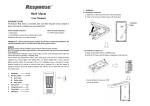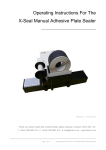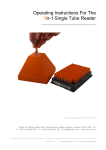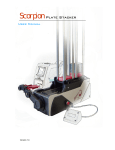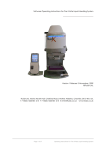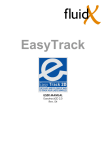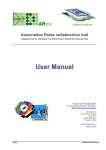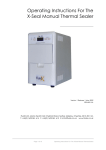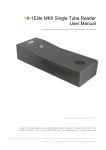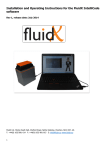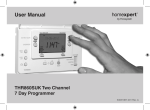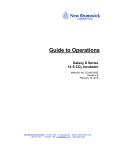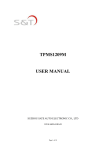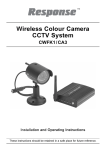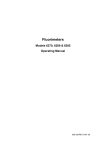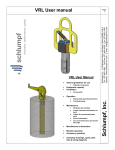Download HT300A USER MANUAL
Transcript
Operating Instructions For The X-Seal AAS Automated Adhesive Sealer __________________________________ Version 1 Release 1 November 2009 ©FluidX Ltd. FluidX Ltd. Monks Heath Hall, Chelford Road, Nether Alderley, Cheshire, SK10 4SY, UK. T: +44(0) 1625 861 614 F: +44(0) 1625 861 615 E: [email protected] www.fluidx.co.uk Page 1 of 35 Operating Instructions For Automated Adhesive Sealer This document is for information only; the manufacturer accepts no liability for errors contained herein or for incidental or consequential damages with the furnishing, performance, or use of this material. Unless otherwise specified references to names or parts is purely casual and has the purpose of illustrating the product. The contents of this publication may not be reproduced in any form or by any means (including electronic storage and retrieval or translation into a foreign language) without prior agreement and written consent from the copyright owner. The information contained in this document is subject to change without notice. Page 2 of 35 Operating Instructions For Automated Adhesive Sealer TABLE OF CONTENTS 1. INTRODUCTION 4 2. DIRECTIONS FOR USE 5 3. HEALTH AND SAFETY 6 4. CONNECTING AIR SUPPLY 9 5. CONNECTING VOLTAGE SUPPLY 10 6. SWITCHING ON THE SYSTEM 11 7. FOIL OR FILM LOADING 12 8. PLATE SUPPORTS 15 9. INTERCHANGING THE ROLLER AND PRESSURE CONTROL 16 10. FOIL / FILM POSITION & LENGTH 17 11. OPERATION PROCEDURE AND OPTIMISATION 18 12. FURTHER INFORMATION 21 13. RECOMENDED SEALS 22 14. COMMUNICATION PROTOCOL 23 15. COMMANDS 27 16. CLEANING 28 17. SPECIFICATIONS 29 18. MAINTENANCE 30 19. FAULT FINDING 34 20. DECLARATION OF CONFORMITY 35 Page 3 of 35 Operating Instructions For Automated Adhesive Sealer 1. INTRODUCTION For your own personal safety please read this manual before operating the Automated Adhesive Sealer. The X-SEAL AAS System has been designed for robotic integration, offers a fast effective solution for the cold roll sealing of microlitre plates for experimentation, storage or transportation. Cold plate sealing is rapidly becoming the new process for the effective sealing of 96, 384 and 1536 plates. The extensive range of sealing materials now available for our new instrument give permanent or peelable high integrity seals for all plate material types. The range includes ultra clear materials for colorimetric or fluorimetric assays, along with solvent resistant seals with low temperature (-80°C) storage characteristics. The new X-SEAL AAS has been designed for bench top mounting with clean lines, easy access and operation. It features a serial port allowing RS232 communication for robotic control plus a touch screen for manual operation. Seal process time and pressure is fully adjustable with visual indication for operation fault and ‘low foil’ warning. X-SEAL AAS can be as easily integrated into robotic platforms from all leading automation companies. Manufactured for: Manufactured by: fluidX Ltd. Monks Heath Hall Helford Road Nether Alderley Cheshire SK10 4SY UK KBiosystems 5 to 10 Paycocke Close Paycocke Road Basildon Essex SS14 3HS UK Tel: +44 (0) 1625 861 614 Fax: +44 (0) 1625 861 615 Email: [email protected] www.fluidx.co.uk Page 4 of 35 Operating Instructions For Automated Adhesive Sealer 2. DIRECTIONS FOR USE The unsealed plate is placed on a shuttle, which extends from the front of the sealer, allowing full access with a robotic arm. The shuttle is drawn into the unit automatically and the plate can be sealed in 12 seconds, depending on the plate, foil and roller pressures selected. The shuttle then slides the sealed plate out, presenting the plate back to its original position. The sealer, as part of a fully automated plate handling system, which can be controlled via a PC using a RS232 communication protocol, Alternatively the X-SEAL AAS can be manually operated as a stand alone unit using the built–in touch screen display. Each roll of cold roll sealing foil/film is supplied with a backing sheet and is sufficient for appox two thousand five hundred plates. The transfer platen cuts the foil to cover the entire plate surface but does not permit any overhang down the side, which would affect the plates handling, or the visibility of barcodes. The foil can be trimmed to fit the exact length of the plate, or have a ‘tab’ to assist with foil removal, when required. The rolls of sealing foil/film are either aluminium or clear laminates and are able to produce permanent, pierceable or peelable seals with Polypropylene, Polystyrene or Polythene Microwell plates. To keep the size and weight to a minimum, the unit uses clear and dry compressed air and all parameters, such as time and pressure are fully adjustable to ensure a perfect, even seal with different plate and film formats. User safety has been carefully considered during the design process, to eliminate risk of contact with moving parts of the internal mechanism during operation. Page 5 of 35 Operating Instructions For Automated Adhesive Sealer 3. HEALTH AND SAFETY It is Important that the X-SEAL AAS is installed and operated in such a way that all applicable Heath and Safety requirements are met. It is the user’s responsibility to ensure that all relevant Health and Safety Regulations are identified and complied with. Failure to do so, may result in damage to the equipment and could cause personal injury. In particular, the user should study the contents of this guide carefully before handling or operating this equipment. Under no circumstances will the supplier of this equipment be liable for any incidental, consequential or any special damages of any kind whatsoever, including but not limited to lost profits arising from, or in anyway connected with the use of this equipment or this instruction manual. Warnings Do not operate this instrument in an atmosphere containing explosive gases. Only approved, supplied mains cord must be used with this instrument. If an extension lead is required, the lead MUST be earthed. Safety guards MUST be used at ALL times during the operation of the unit. Always remove the sealing film before transporting the sealer. The unit should only be used in a suitably ventilated area. The use of solvents on the unit is not recommended. Certain components become hot during the correct operation of the equipment. These are marked as below. Due care should be taken to avoid personal injury. Disconnect air supply and electrical supply before removing safety guards. Warning symbols Risk of electric shock. ! Moving equipment. Earth protective conductor. Page 6 of 35 Operating Instructions For Automated Adhesive Sealer Operating conditions Temperature Range: Operating 15º C to 40º C Storage 0º C to 40º C Relative Humidity: Operating 10% to 80% Non-condensing Storage 10% to 80% Non-condensing Voltage: The Automated Thermal Sealer is supplied for direct connection to normal 115VAC or 240VAC supply, with a variation of 108VAC to 250VAC. The following fuses are fitted to the Automated Thermal Sealer: Supply 230VAC 115VAC Fuses Fitted in Plug 13 Ampere No Fuses Fuses Fitted in Sealer T5AH 250V T5AH 250V Only refit the correct type of fuse. Must be IEC127 approved for use in EC Countries. Must be C.S.A. or UL listed or recognised for use in Canada or the United States of America. Operate the Automated Thermal Sealer in a draught-free environment to help maintain temperature stability. The time between cycles may increase if sealing plate cools. Place the unit on a secure bench to avoid movement during use. Allow 170mm at the front of the instrument for operation of the plate carrier. The X-SEAL AAS should be only operated in an environment with a temperature range of 15°C - 40°C and a non-condensing relative humidity range of 10% - 80% . The unit should be kept out of draughts and air currents as they will have an adverse effect on the temperature stability of the sealing platen. The machine should be mounted on a sturdy bench to avoid any bounce during operation. When locating the machine there should enough space allowed for the shuttle to extend without hitting anything or anybody. The reduced weight makes the X-SEAL AAS much easier to move into a suitable position. Page 7 of 35 Operating Instructions For Automated Adhesive Sealer Operating conditions Shown below is the main control PCB showing the fuse position and layout. All fuses used upon this unit are T rated (Time lag) and H (High Breaking Capacity) 1 Amp Fuse Page 8 of 35 Operating Instructions For Automated Adhesive Sealer 4. CONNECTING AIR SUPPLY All electrical and pneumatic connections are made to the lower rear of the unit (Fig. 6). This is the only point of interconnection. UK Europe and Asia supplied units. The unit is supplied with a 6mm push-in connector to fit into the 1/4 BSP inlet. USA supplied units. The unit is supplied with a 1/4 inch push-in connector to fit into the Filter Regulator input. When fitting an air connector to the Automated Thermal sealer prevent the bulkhead fitting from turning while tightening the connector to prevent loosening. Air supply should be 80psi (5.5 bar) / 87psi (6 bar) max. Provide 50 litres/minute through a pressure regulator as there is no air regulation of the air within the instrument. NOTE Exceeding the maximum pressure may damage the unit. The air supplied must be clean, dry and oil-free. Most air regulators include a water filter but not an oil filter; this may need to be fitted separately. Fig. 6 The air supply for the X-SEAL AAS should be 80psi ( 5.5 bar ) and a maximum of 87psi ( 6 bar ). The supply should be able to provide 50 litres/minute through a pressure regulator as there is no regulation of the air within the X-SEAL AAS. Exceeding the maximum pressure may damage the unit. The air supplied must be clean, dry and oil-free. Most air regulators include a water filter but not an oil filter; this may need to be fitted separately. Page 9 of 35 Operating Instructions For Automated Adhesive Sealer 5. CONNECTING VOLTAGE SUPPLY The Automated Thermal Sealer utilizes a standard IEC inlet, which is fused and switched. Plug the IEC lead in the inlet and switch on the rocker I.O. switch (Fig. 7). The display mounted on the front of the unit should illuminate. NOTE The system is self regulated to sense voltage differences between 100 and 240 VAC. Fig. 7 NOTE: If the X-SEAL AAS. Fails to power up when correctly connected, then check the external fuse at the rear of the machine – see above photo. If this fuse has failed then a replacement 5A anti-surge fuse is included with machine. If this fuse is intact then an internal fuse may have failed. Either contact ABgene® or your distributor before removing the main cover. The photo above shows the location of the fuse that may have blown. It is a 1A anti-surge fuse and 2 replacements are provided with the machine. Also check that the E-Stop is in its operational position i.e. fully out. Page 10 of 35 Operating Instructions For Automated Adhesive Sealer 6. SWITCHING ON THE SYSTEM When the power is successfully connected to the sealer, the touch screen display will light up and the display will be as Display 1. Display 1 The unit will sound three times whilst the system starts and the display will change to as shown in Display 2. Display 2 The next screen then waits for the proceed area of the screen to be touched. Display 3 After proceed has been touched, the initialising screen is displayed and remains until the shuttle homes into the sealer and returns to the preset plate loading position. Display 4 Page 11 of 35 Operating Instructions For Automated Adhesive Sealer The next screen gives the option to proceed with the sealing action or go into the set up choice area. The correct plate length and number of rolls can be checked to that displayed. Ensure that the correct plate and carrier are loaded onto the shuttle prior to sealing. The set up will take into the multi-choice screen to select the option required. Display 4 7. FOIL OR FILM LOADING To load the foil/film. When starting from new, or after using the reel for some time, the low film alarm will indicate that a new foil or film reel needs to be loaded. When this alarm is displayed during use, it indicates that the foil or film roll has only a certain number of seals left available from the loaded roll. The number of seals left after the alarm appears is variable through the position of the foil sensor and normally factory set to that stated in the original specification. The next screen is displayed whilst the sealer sets itself to the foil loading condition. This requires that the cutter is raised clear of the foil area and that all moving parts are homed. Display 6 Display 7 Once this screen is displayed, the sealer must then be switched off prior to the foil/film reel being loaded. The display will then go blank and the air will be vented and isolated. See later parts of this chapter 8 for details on how to load the foil/film Display 8 After the procedure for loading the foil/film has been completed and the doors all closed with power and air reapplied, the sealer can then be switched back on. The start-up displays all appear as already defined, and then display 8 waits for confirmation that the service door has been opened and the foil off cut removed. The service door opening will cause the air to be evacuated, this will be restored once the door is closed and locked shut. Display 5 is then shown ready to continue. Display 9 Page 12 of 35 Operating Instructions For Automated Adhesive Sealer Always ensure that sufficient room is made around the side cover area to permit easy access for loading the foil, installing the blank foil backing spool and for threading the foil through the guide rollers and into the cutter. The mains and air supply must be connected to load the foil. The screen offers a foil load option to ensure that the internal mechanism is moved to the default locations. The cutter is powered to the up position, ready for the foil loading. When the side cover is removed the interlock mechanism immediately exhausts all of the air within the instrument and allows the foil to be placed through the open punch/die and foil clamp assembly, to allow the film and backing to be threaded through the system. Both foil and backing spindles that contain the roll of film are fitted with manually adjustable clutch mechanisms. The side cover is removed by first undoing the two retaining knobs and the side cover can then be carefully removed outwards. This action will immediately cause the internal air supply to be cut off - an air discharge will be heard and this is normal. Care should be taken with the side cover since the control interlock mechanism on the side cover is now exposed and could cause injury or damage. The two fixing knobs should also be safely stowed for later reuse after foil loading is complete. A diagram is located on the side of the unit detailing the path of the foil and backing film. The top spindle holds the full or part full reels of foil or film. This is loaded onto the spool that fits the top spindle. This spool has a smaller spindle hole (18mm) and the red spool-locking ring has a left hand thread. After clamping the foil securely and fitting to the top spindle, taking care to have the foil fitted onto the spool he right way round – see diagram for rotation direction, the white inner washer (18mm bore), the spring, the outer metal washer (18mm bore) and the knurled clutch adjusting nut (18mm LH) should be screwed half way onto this shaft (LH). An empty reel core should then be firmly fitted to the second spool. This spool has a 20mm bore and 20mm clutch components and should be fitted to the lower spindle, similar to the procedure for the top spool. The knurled nut should then be screwed on to about half way (RH). The foil end and backing should then be unfastened and passed under the central fixed guide roller and towards the cutter area, but over the horizontal flat platen. The backing Page 13 of 35 Operating Instructions For Automated Adhesive Sealer should then be peeled away from the foil or film and passed down between the rounded end of the platen and the rear of the cutter block. As the backing is pulled down and around the lower fixed spool, the foil or film should be fed through and over the open cutter block. Extreme care should be exercised when in the cutter area since sharp surfaces are present and accessible. The cutter itself is retracted 100mm above the cutter block and since the air has been evacuated and isolated, the cutter can only slowly lower through gravity and so should impose no real risk other than keeping clear of the very sharp edges. After feeding the foil or film through the cutter, the backing can be then pulled around the lower fixed guide and onto the empty reel core already fitted to the lower bobbin. This will need to be secured centrally to the core using sticky tape. See the diagram printed on the side of the X-SEAL AAS. for the exact foil and backing route and direction. Once the backing has been secured and several turns made to start the reel off, the side cover can be refitted, taking care with the protruding interlock mechanism, place the cover on towards the main cover and located the interlock peg into the hole. After ensuring that the peg is located properly and that the fixing studs have passed through the side cover, the knobs can then be refitted. Over tightening of these knobs is not necessary. The screen prompt should then be touched to start the final stage. This will permit the air back into the system and lower the cutter to trim off the excess foil or film that has been previously fed through the cutter whilst loading. The front access door should now be carefully opened and lowered. This action will again operate the safety system and evacuate the air from the X-SEAL AAS. Again this is normal. Access to the off cut of the foil or film can then be gained to the right of the doorway. After extracting the foil off cut, the door must be securely closed to continue. The internal air supply will then be reconnected. The final step is to make sure that the tension for both spools has been correctly set and that the foil or film is feeding correctly. To ensure that the foil or film is presently correctly to the transfer suction head, it is necessary to have the cut end of the foil or film tacked onto the pads located under the cutter. The spool is then driven backwards by a motor and gearbox, which gives the tension to present the foil or film flat and in line for the transfer suction head. Too much tension (anti-clockwise) will break the hold at the tacked cut end-too little (clockwise) and the foil will sag over he platen and so give no assistance to the suction pickup. This could lead to either transfer failure or a wrinkled plate seal. The lower spool is also driven but in the opposite direction to the top spool. This assists with keeping the foil flat over the platen. The tension of the lower spool should be adjusted to take up the surplus backing discharged from the end of the platen. Too much tension (clockwise) will cause the foil or film to be pulled down over the cutter end of the platen, too little tension (anti-clockwise) will prevent the lower spool from keeping pace with the backing discarded and could result in the backing being pulled through the cutter. This will put undue stress on the cutter block and should be avoided. Please note that the spool tension adjustments are opposite to each other. After becoming familiar with the foil or film installation procedure, the system can be quickly loaded and operational, particularly if the same foil or film is being reloaded since the settings already established may not need adjusting, as it is not necessary to remove the bobbins to reload a new reel. Part used reels as well as full reels can be loaded onto the top bobbin. However, care should be taken in loading non-empty cores to the lower bobbin since over capacity will be detrimental to the clutch mechanism and the backing could become unguided onto the bobbin. This could cause the backing to foul with other moving parts within the X-SEAL AAS and cause plate sealing failure. Page 14 of 35 Operating Instructions For Automated Adhesive Sealer 8. PLATE SUPPORTS Plate supports are found in the spares kit provided and support the under side of the plate to ensure that the seal is even across all the wells of the plate. To select the correct plate support, measure the underside of the wells to the bottom skirt and select a support which is slightly larger. Page 15 of 35 Operating Instructions For Automated Adhesive Sealer 9. INTERCHANGING THE ROLLER AND PRESSURE CONTROL The roller is located immediately behind the service door, located at the front of the instrument. When the main door is carefully lowered and laid flat, the roller and fixings can easily be seen and accessed. This will cause the interlock to exhaust the system air and isolate the incoming air supply until the door is closed. The roller assembly can be removed by undoing the three fixings with the supplied Allen key. The yoke assembly can then be rotated through 90 degrees and lowered through the shuttle opening. The procedure to replace the roller is as above, taking care not to damage the roller and that the yoke assembly is rotated in the correct direction to locate the yoke upper surface with its mating part, attached to the cylinders. Prior to fitting ensure that the correct roller has been selected and that the roller is free to rotate on its spindle. The locking screws at the rear of the yoke should also be checked for tightness, since access to these is reduced once the yoke assembly has been installed. To achieve the correct sealing for different plates and foils or films, the X-SEAL AAS incorporates a manual adjustable pressure regulator and analogue gauge with a range of 04Bar (0-0.4Mpa). The pressure is initially set for about 1 bar and should suit most sealing applications. During operation, the gauge displays the pressure set for the roller. The roller pressure is adjusted through a precision control located above the pressure gauge. These are both secured into the main frame of the X-SEAL AAS and can be accessed only when the side cover is removed. During operation, the gauge can be seen to operate during the rolling operation. This pressure is manually adjusted using the knob. Rotating the knob clockwise (+) will increase the pressure whilst rotating anti-clockwise will reduce the pressure (-). One full turn of the knob is approximately equal to 1 Bar (14.5 PSI or 0.1 MPa), so by careful rotation, the desired pressure can easily be assessed and set. The units are normally despatched with the pressure set to 1 Bar. As described above, to adjust the pressure it is necessary to remove the foil side cover. Rotating and removing the two side facing knobs do this, will then permit the cover to be carefully moved SIDEWAYS, to permit the safety interlock mechanism to disengage from the main frame assembly. This will cause the interlock to exhaust the system air and isolate the incoming air supply until the door is closed. Adjustments in the pressure required for each set-up for variations in plate type, foil type and roller type will quickly become familiar with use and often permit the correct set up to be set at the first attempt. As with changing foils and having to adjust the spindle clutch pressures, the more the operators become familiar with the instrument, the resulting set-up time will become quicker. To aid in roller selection, the different types have been colour coded. Each former for the roller will be coloured to quickly identify the type of roller and its hardness. A full reference chart will be found in the specification chapter within this manual. Page 16 of 35 Operating Instructions For Automated Adhesive Sealer 10. FOIL / FILM POSITION & LENGTH There is some limited adjustment available that can alter the position of the foil on the plate and of the length of the cut foil. The fore and aft adjustment of the foil can be used to vary the amount of overhang of the foil at the back an front of the plate. The side to side adjustment can be used to place the foil so that the numbers on the plate are visible. The foil length can be adjusted from a minimum to suit robotic piercing to a maximum to provide a tab for peeling. The adjustment of all these parameters is very similar in that the position stops that must be adjusted are all of the same type. These stops have a threaded body that is M10 with a pitch of 1mm so that one full turn of the stop will result in a change in position of 1mm. All of the adjustments require the cover to be removed. 10.1 Foil length The foil length is set at 125mm initially and may be adjusted to increase this by a maximum of 5mm each end. This standard factory setting of 125mm cannot be reduced; doing so may cause the foil vacuum cups to become uncovered. To create a tab at the front of the plate the stop at the rear of the fore and aft transfer must be adjusted and the same to create a tab at the rear of the plate, the stop at the front of this transfer is to be adjusted. Note: All adjusted positions are to be checked with cutter in the down position to ensure against crashes 10.2 Side to side placement The foil placement position may be changed by up to 5mm on each of the plate. To move the foil further to the left, adjustments are to be made the left hand stop located on the top of the transfer unit. The same is for moving the foil further to the right adjust the right hand stop. Page 17 of 35 Operating Instructions For Automated Adhesive Sealer 11. OPERATION PROCEDURE AND OPTIMISATION The X-SEAL AAS System has been designed to reliably seal plates of different heights and different plastics, using a variety of foils and films, to give a seal with varying properties. These components will require different sealing conditions. The quality and strength of the seal created between the sealing films will vary with different conditions. In general, increasing either the sealing pressure or duration of seal, gives a stronger, more complete seal. However over-sealing on a regular basis is not recommended, as applying more pressure can cause damage to the plate being sealed. This in turn, would reduce the number of times a particular plate can be resealed. Therefore a balance has to be achieved, that gives an acceptable seal with the minimal plate damage or distortion. Another optimisation factor to be taken into account is the surface area of the plate. A plate with thin raised rims around each tube (chimney), will have a reduced surface area, compared to a flat plate or with wide raised rims. This would mean that less pressure is needed to seal the thin rim plate in comparison to the wide rim. The pressure that the roller exerts during sealing is fully adjustable, as is the speed of travel for the shuttle. From the set up on screen display 5, the choice menu is displayed as shown on display 6. Selecting the roll set up option will then display screen 10. This allows for the pre-measured plate length to be set. Pressing enter will then move onto the next screen. Display 10 This next screen permits the number of foil/film rolls to be set. Pressing enter will then move onto the next screen. Display 11 This next screen permits the exact position for the shuttle out location. This sets the range of 235 to 275 units. Pressing enter will then move onto the next screen. Display 12 Page 18 of 35 Operating Instructions For Automated Adhesive Sealer This next screen permits the choice for half or full rolling. If yes is toggled, then the rolling procedure is to roll from the centre of the plate to the back, raise the roller and move back to the centre and then roll from this position to the front. The roller then stays down and the shuttle and plate move forward so completing a final full length roll. Toggling for no on the display eliminates the final full roll. Pressing enter will then move onto the next screen. Display 13 There is a facility to operate the machine remotely. This screen permits the option to be selected by toggling yes or no. Selecting yes will activate the RS 232 connector at the rear of the unit. Pressing enter will then move onto screen 16 if the remote option is not selected. Display 14 If the RS232 option is selected, then screen display 15 becomes active. This allows for the RS232 option to be de-selected by selecting the set up option on this screen. This will then revert back to screen display 14 where the no option can be toggled. Again, pressing the enter area will move onto screen display 16. Display 15 The roll speed for the plate sealing is adjustable to cater for the requirements of different rollers, plates and foils/films. The adjustable range of 1 to 50 permits for the slow rolling requirements of some films, typically crystallography which is set at around 10, but this is normally set at 50 for fast rolling. Pressing enter will then move onto the next screen. Display 16 To permit curing time for some foil/film glues after they have been cut, a delay is selectable from 0 to 5 seconds to allow the exposed glue at the cut edges to air dry and become less tacky. This prevents any possibility of wrinkles being formed during the plate sealing operation. Pressing enter will then go back to screen display 6. Display 17 Page 19 of 35 Operating Instructions For Automated Adhesive Sealer This screen is displayed as shown in display 18. This is similar to screen display 5, but defines that the sealing operation has commenced and is always displayed after screen 5. Display 18 11.2 Commands, Indications and warnings. The X-Seal System is software controlled, employing micro-controllers. All commands, indications and warnings are affected via the touch sensitive LCD Display Panel located on the front of the unit. The user-friendly menu regulates all operations. The Sequence of events is as follows:11.3 Initiating Unit Operation. Loading the machine with foil and triming the foil is described under section 8. The display is used to set the sequence. 11.4 Foil low sensor There is a sensor mounted below the spindle to provide a warning that the foil is running low. As supplied the sensor is in the centre position of five possible positions. It may be adjusted up or down to increase or decrease the amount of foil remaining when the warning is given. 11.5 Cover removal All power and air connections must be removed prior to the removal of the cover. Should it become necessary to remove the cover it is secured by three screws on one side and by two on the other side. The small side cover over the foil roll also needs to be removed. To lift the cover the foil spindles need not be removed or the clutch loosened as the cover can slide behind the bobbins. The shuttle and service door are not part of the cover. These are attached to the base unit. Once the cover has been lifted up so that it is clear of the power and air inlet the ribbon cable connecting the display to the circuit board is revealed. This must be disconnected before the cover can be removed completely. The cover should be lifted at the back to ease it over the front of the machine. Replacing it is the reverse of removal. 11.6 Internal fuse failure If a voltage outside of the 100 to 240VAC is applied to the unit then the internal fuse will fail. This is a 5A type F fuse and is installed into the built in fuse holder as part of the mains inlet panel. This can be clearly seen in the adjacent inlet panel assembly pictures. Page 20 of 35 Operating Instructions For Automated Adhesive Sealer 12. FURTHER INFORMATION The amount of times a microplate can be sealed and resealed can be increased by using the minimal amount of temperature and seal time to prevent chimney damage. Sealed microplates that have been stored in a fridge or freezer do not always have to be brought back to room temperature before peeling e.g. FluidX EZ Peel, a peelable heat seal for polypropylene plates. (See the complete FluidX range for more information). FluidX has not yet tested seals from alternative suppliers and therefore is unable to make recommendations regarding their usage at this time. To prevent the risk of cross-contamination between wells when removing a peelable seal, consider using one that can be pierced. Centrifuging before removal may also be beneficial. Page 21 of 35 Operating Instructions For Automated Adhesive Sealer 13. RECOMENDED SEALS Heat Seal Rolls 40-1001 40-1002 40-1003 40-1004 40-1005 40-1006 40-1007 40-1008 40-1009 40-1010 40-1011 40-1012 43-1032 43-2032 Adhesive "Gold" Aluminium Sealing Foil (peeling). Good solvent resistance, Temp range; minus 80°C to 120°C. 100m per roll (approx. 800 plates) for use with Xcs-384 Adhesive Aluminium Sealing Foil (piercing). Good solvent resistance, Temp range; minus 80°C to 120°C. 100m per roll (approx. 800 plates) for use with Xcs-384 Adhesive Polyolefin film (peeling). Micro-encapsulated solvent. Temp range; minus 25°C to 120°C.100m per roll (approx. 800 plates) for use with Xcs-384 Adhesive Polyolefin film, pre-pierced for good gas exchange, Temp range; minus 25°C to 120°C. 100m per roll (approx. 800 plates) for use with Xcs-384 Adhesive gas permeable membrane, impervious to fluids but provides good gas exchange. 100m per roll (approx. 800 plates) for use with Xcs384. (81mm width, requires 45-1100 adapter) Adhesive Polypropylene film (peeling). High solvent resistance. Temp range minus 80°C to 120°C. 100m per roll (approx. 800 plates) for use with Xcs-384 Adhesive Cristal Clear Polypropylene film (peeling). Solvent resistant. Temp range minus 40°C to 120°C. 100m per roll (approx. 800 plates) for use with Xcs-384 Adhesive PCR Film Roll (AB-2558) (100m) on 80mm backing, for use on Abgene format sealer and XCS-384 (81mm width, requires 45-1100 kit). Adhesive PCR Foil Roll (AB-2626) (200m), Abgene format sealer Black PE Sealing foil, Peeling, light tight, good biological and solvent resistance, Temperature range: -40°C to +60°C, for use with Xcs-384 Adhesive silicone foil, Piercable, high solvent resistance. Ideal for sealing plates containing DMSO. 150M per roll, to seal approximately 1200 plates. (81mm width, requires 45-1100 adapter) Adhesive silicone foil, Peelable, high solvent resistance. Ideal for sealing plates containing DMSO. 150M per roll, to seal approximately 1200 plates. (81mm width, requires 45-1100 adapter) QPCR adhesive clear seals (AB-1170), Optically clear for QPCR and other fluorescence applications, (500m x 115.5mm), Peelable seal for PP and PS plates, Velocity 11 format (41-1004 Equivalent) QPCR adhesive clear seals (AB-1170), Sample Roll (25m), Optically clear for QPCR and other fluorescence applications, (25m x 115.5mm), Peelable seal for PP and PS plates, Velocity 11 format (41-1004 Equivalent) Page 22 of 35 Operating Instructions For Automated Adhesive Sealer 14. COMMUNICATION PROTOCOL Introduction The 9 pin D type at the rear of the unit is labelled RS232 and is for connecting the X-Seal to a PC using a serial port. The PC then uses the protocol detailed in section 13 to communicate with the X-Seal This allows the sealing parameters to be programmed from the PC; enabling the PC to request status information from the X-Seal; provides low foil and other warnings to the PC. Serial Port Set-up 9600---Baud rate 8 Data bits No parity 1 Stop bit No handshaking All communications via Ascii. Cable PC (9 way female) Pin 2 Pin 3 Pin 5 SEAL-IT 100™ (9 way female) Pin 2 Pin 3 Pin 5 Message Response time The unit responds to each message within 100 Millisecond. Configuring for remote operation On the touchscreen use the advanced menu to set the following: When the system is powered up the operator is prompted to clear the plate load area before the plate shuttle is extended. “Mode” to “Rmt”. This sets the unit into remote mode and ignores commands issued from the touch screen. This is strongly recommended when controlling the unit from a host computer. Once unit has been set to remote mode the unit must be restarted to allow remote control. Page 23 of 35 Operating Instructions For Automated Adhesive Sealer System Initialisation Once unit has been restarted it must be initialised via the PC PC sends I<cr> X-SEALreplies: ok<cr> Status Message PC sends ?<cr> X-SEALreplies: <status byte><cr> The status byte is a hexadecimal value represented in Ascii, ie the characters "ff" means 0xff hex. bit values: bit 0 Low Air bit 1 error bit 2 Sealing bit 3 Low air during seal bit 4 Not initialised bit 5 Low foil bit 6 Door open/side cover missing Begin Sealing Command PC sends S<cr> X-Seal replies ok<cr> if the sealing operation has commenced or err<cr> If it is unable to start the operation. Page 24 of 35 Operating Instructions For Automated Adhesive Sealer The seal it will not start sealing if the following conditions exist: bit 0 low air bit 1 error bit 2 sealing bit 3 low air during seal bit 4 Not initialised bit 5 low foil bit 6 Door open/side cover missing Error Message PC sends E<cr> X-Seal replies ##<cr> where ## is a decimal value represented in Ascii, ie the characters "01" means error 1. Modify Seal Parameters Note: Wait until unit is in idle state before modifying seal parameters. PC sends P%=###<cr> X-Seal replies: ok<cr> where % is the parameter number and ### is the parameter value. % is a single digit decimal number and ### is a 3 digit decimal number represented in Ascii e.g. The string P1= 127<cr> plate length to 127mm The following parameters can be set Page 25 of 35 Operating Instructions For Automated Adhesive Sealer Parameter 1 Description Plate length Units 124mm to 128mm 2 Number of rolls 1 to 5 3 Shuttle roll position 235mm to 275mm 4 Full or half roll 5 Not used 6 Roll speed 7 Not used 8 Autosave 0= Full roll 1= Half roll 1 to 50 0=off 1=on Note:- 1 = Low speed 50 = High speed Reading X-Seal parameters PC sends P%<cr> X-Seal replies: ###<cr> where % is the parameter number and ### is the parameter value. % is a single digit decimal number and ### is a 3 digit decimal number represented in Ascii e.g. To read the current plate length, send the string P1<cr> The X-Seal replies with the string 128<cr> if the plate length is 128mm. Manual Save Seal Parameters (Command R) Normally Seal parameters are written to eeprom so that they can be saved through unit power down. In some applications it may be necessary to turn autosave off (P8 = 0). This is because the action of writing to eeprom may cause occasional corruption of communications messages. If autosave is disabled then it is possible to save the sealing parameters through power down using the R command. Page 26 of 35 Operating Instructions For Automated Adhesive Sealer 15.COMMANDS E<cr> T<cr> O<cr> L<cr> S<cr> I<cr> R<cr> P1=128<cr> P2=2<cr> P3=256<cr> P4=1<cr> P5 P6=30<cr> P7=2<cr> P8=0<cr> Error status Trim Open door Lock Seal Initialise Save Seal Parameters Set plate length in mm Set no of rolls Set load position Set roll type (0 = Full roll, 1 = Half roll) Not used Set roll speed to 30 Set cure delay to 2 seconds (1-5 seconds) Set auto save of parameters on or off P1<cr> Query plate length, similar for all other p variables ?<cr> q Query status This will return an 8 bit hex number in ascii format. Bit values:bit 0 Low Air bit 1 error bit 2 Sealing bit 3 Low air during seal bit 4 Not initialised bit 5 Low foil bit 6 Door open or side cover missing bit 7 Not used Page 27 of 35 Operating Instructions For Automated Adhesive Sealer 16. CLEANING ! ! ! ! Before using any cleaning or decontamination method, other than that recommended by the manufacturer, users should check with the manufacturer that the proposed method will not damage the unit. In case of radioactive spillage's, Advanced Biotechnologies Limited, recommend that you use a proprietary cleaning agent and follow the manufacturers instructions. You may clean the X-Seal cover, with a cloth dipped in water or ethanol, methanol or formaldehyde may also be used. THE UNIT SHOULD NOT BE IMMERSED IN SOLVENTS DO NOT USE ACETONE OR ABRASIVE CLEANERS. Before using any cleaning or decontamination method, other than that recommended by the manufacturer, users should check with the manufacturer that the proposed method will not damage the unit. Always remove the power and pneumatic supplies before cleaning the unit. Do not turn on power and pneumatic supplies until the unit is fully dry. DO NOT USE ACETONE OR ABRASIVE CLEANERS Page 28 of 35 Operating Instructions For Automated Adhesive Sealer 17. SPECIFICATIONS Power Supply: Minimum 100VAC Maximum 240V AC Power Consumption: 150 Watts Nominal Fuse Rating: 5 Amp anti-surge Dimensions: 370 x 433 x 594mm Weight: 28Kg Air Input: 6mm or 1/4 “ BSP Female Thread Air Requirement: 50 Litres per minute Air Input Pressure: 5.5 Bar (80 PSI) Minimum Operating Pressure: 5.5 Bar (80 PSI) Minimum Operating Ambient Temperature: 150C Maximum Working Temperature Ambient: 40oC Minimum Sealing Plate Height: 8mm Maximum Sealing Plate Height: 50mm Protection: IP20 Fire Retardancy: Plastic Case & Trays ECCEN 6073 Cycle Time Minimum: 30 Seconds (Sealing Time Adjustable) Access Panels Interlocked Main cover, Side Cover & Service Door Page 29 of 35 50/60Hz 50/60Hz (W x H x D) Operating Instructions For Automated Adhesive Sealer 18.MAINTENANCE Lubricating and cleaning the cutter The punch and die used in the SEAL-IT 100™ system needs regular lubrication to maintain the quality of the cut of the sheets. Approximately every 2500 cuts (which is approximately after every full roll or if the unit has not been operated for more than 7 days, the following procedure should be carried out. 1. Set the system for as if it were in foil or film reel loading mode. This will raise the cutter for easier access. 2. Remove the side cover. This will automatically evacuate the air within the system and internally isolate the incoming air supply. Leave the mains voltage on. Please ensure that all parts removed during maintenance are kept safe 3. Apply a small quantity of the lubricating grease provided using a spatula or finger to the rear of the heels of the die. Page 30 of 35 Operating Instructions For Automated Adhesive Sealer Rear View 4. Open the service door. Page 31 of 35 Operating Instructions For Automated Adhesive Sealer 6. Apply a small quantity of the lubricating grease provided using a spatula or finger to the front of the heels of the die. 7. Close and secure the service door. Page 32 of 35 Operating Instructions For Automated Adhesive Sealer 8. Replace the side panel and secure with the two knobs, Ensuring that safety plunger is place correctly 9. Press ‘continue’ on the touch screen to resume normal operation. 20.1 CLEANING THE CUTTER The procedure stated above should be used as a safety guide when cleaning the cutter, this should be carried out if unit states to produce poor cutting. 20.2 CLEANING THE SHUTTLE RAILS Wipe the shuttle rails with a clean dry cloth and apply a small amount of lubricating grease along the full length of both rails. Page 33 of 35 Operating Instructions For Automated Adhesive Sealer 19. FAULT FINDING THIS EQUIPMENT SHOULD ONLY BE DISMANTLED BY PROPERLY TRAINED PERSONNEL. REMOVING THE MAIN COVER EXPOSES POTENTIALLY LETHAL MAINS VOLTAGES. The X-Seal Automated Adhesive Sealer has been designed to give long term reliability with the minimum of maintenance. Annual maintenance is recommended to maintain instrument integrity and optimal performance. Should a problem occur with the sealing, an initial inspection of the component may identify cause and necessary action required. 21.1. ERROR CODES Error 2 Shuttle failed to reach the HOME switch Error 4 Low air glitch- Air loss during cycle Error 6 Failed to reach foil transfer REAR switch Error 7 Failed to reach foil transfer FRONT switch Error 8 Failed to reach foil transfer R-H switch Error 9 Failed to reach foil pick UP switch Error 10 Failed to reach foil pick DOWN switch Error 11 Failed to reach cutter UP switch Error 12 Failed to reach foil transfer L-H switch Error 13 Failed to reach roller UP position Error 14 Door open Page 34 of 35 Operating Instructions For Automated Adhesive Sealer 20. DECLARATION OF CONFORMITY As detailed under the European Machinery Directive 89/392/EEC (amended by 91/368/EEC) and under the UK legislation. The supply of Machinery (Safety) Regulations 1992 (SI 1992/3073). As detailed under The Electromagnetic Compatibility Directive 89/336/EEC (amended by 91/263/EEC and 92/31/EEC and the UK legislation, the Electromagnetic Compatibility Regulations 1992. As detailed under The European Low Voltage Directive 73/23/EEC (amended by 93/68/EEC) and the UK legislation, The Electrical Equipment (Safety) Regulations 1994 The Declaration of Conformity is provided for the following equipment:Equipment Automated Adhesive Sealer The X-Seal AAS has been type tested by- Intertek Testing Services and issued report No. EM02007020 and EM02007020 to the following EMC Standards: BS EN 55-022 Class A BS EN 50-082-2 Emission Immunity Transposed Harmonised Standards BSEN 12100-1 Safety machines: Concepts General: principles for design; basic terminology & methodology BSEN 12100-2 Safety of machines: basic concepts, general principles for design; technical principles BSEN 61010 Safety requirements for electrical Equipment for measurement, control & laboratory use BSEN 60204 safety of Machinery; electrical equipment of machines (section 19) BSEN 50081-2 environment Electromagnetic Compatibility; generic emission standard, industrial BSEN 61000-6-2 Electromagnetic compatibility (EMC) Generic standard, immunity for industrial environments Other Standards BS5378 safety signs & colours Name & Address of the Responsible Person within the EU I declare that as the Authorised representative, that the above information in relation to the supply/manufacture of this product, is in conformity with the stated standards and other related documents, following the provisions of (89/392/EEC) Alan A E Shepherd Units 5 to 10 Paycocke Close Basildon Essex SS14 3HS United Kingdom Page 35 of 35 Operating Instructions For Automated Adhesive Sealer




































